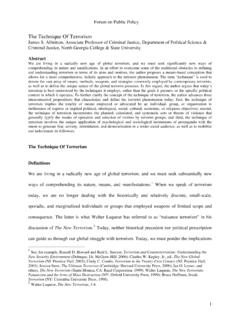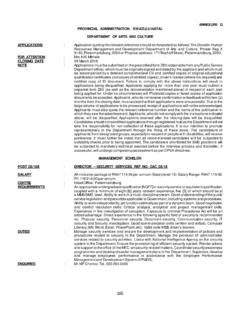Transcription of Strategies for Improving Ethical Behaviors in …
1 Forum on Public Policy 1 Strategies for Improving Ethical Behaviors in Organizations Gabriel Omolewu, Associate Professor of Management, Wilberforce University Abstract The media bombards us with accounts of unethical Behaviors in organizations which reveal social issues that demand our attention. These Behaviors are from individuals with no moral character and have raised a lot of concerns about business ethics. This paper examines the unethical Behaviors , their causes, and the Strategies for reducing their occurrence. Unethical behavior is one that is not morally right or one that is prohibited by the law.
2 It includes corruption, mail and wire fraud, falsification of time cards, discrimination and harassment, insider trading, bribery and kickbacks, conflicts of interest, improper use of company assets, embezzlement, and other forms of dishonesty and cheating. The causes of these unethical Behaviors in organizations are weak levels of supervision and accountability, inadequate administrative structure, lack of awareness of the public and employees, and unmonitored declaration of employee assets. Strategies to reduce the unethical Behaviors include establishments of codes of business conduct and a whistle-blowing mechanism and a commitment by management to annual business ethics training for employees.
3 Introduction Ethics is the study of morality. It is the value that is worth pursuing in life. It is honorable behavior . Ethics is relative. What is honorable in one society may not be honorable in another. It depends on several factors: world views, descriptive values and moral values. It is a function of the environment. What one salesperson may consider being an unethical marketing behavior , another salesperson may perceive it as an aggressive marketing strategy. Ethics can be illustrated with the popular story of a millionaire who built an Olympic size swimming pool for his evening enjoyment.
4 He filled the pool with many crocodiles of different types and sizes. His own idea of enjoyment is to watch these crocodiles swim every evening. At the completion of the construction of the swimming pool, he invited all the elites of the city to its dedication. As people were eating and drinking, an announcement was made by the host, over the public address system, that if any young man was bold enough to swim across the swimming pool, he would be given one of two things: a real estate that worths $1 million or his only beautiful daughter in marriage. Before he finished his announcement, a young man jumped into the swimming pool, to the surprise of everyone, swam across the pool and got out without a Forum on Public Policy 2 single bruise on his body.
5 The millionaire ran to him, gave him a big hug and asked him what he would like to receive out of the two. The young man said he did not want any of them and that the only thing he wanted was, he wanted to know the bastard who pushed him into the swimming pool. That is ethics. The young man told the truth. He did not want any of the two rewards promised by the millionaire because he did not, on his own, jump into the pool. He was pushed by an unknown person. The millionaire too behaved honorably. He did not believe anyone could jump into the swimming pool to swim across. Since somebody did, he was still willing to stand by his words.
6 He did not say he was not willing to give his only daughter in marriage to a stranger. Unethical Behaviors The media feeds us with information of unethical Behaviors in our environment revealing the unethical social issues that demand our attention. The newspaper accounts of unethical Behaviors in business have raised concerns about business ethics which have led to studies on their causes in organizations (Carroll, 1978, 4). These unethical Behaviors are from unsavory individuals that have no moral character. In 1961, the survey conducted by Reverend Raymond C. Baumhard S. J.
7 , showed that there was a very high concern about Ethical Behaviors . That concern is higher today (Brenner & Molander, 1977, 57). What is an Unethical behavior ? The Civil Service Commission of Philippines defined an unethical behavior as any behavior prohibited by law. In a dynamic business environment, a large gray area exists that makes it Forum on Public Policy 3 difficult and unclear to distinguish what is Ethical . An unethical behavior would therefore be defined as one that is not morally honorable or one that is prohibited by the law. Many Behaviors will fall in the classification including corruption, mail and wire fraud, discrimination and harassment, insider trading, conflicts of interest, improper use of company assets, bribery and kickbacks, compliance procedures, Ethical relations with others, disciplinary action, fraud, illegal business donations, patent infringement and product liability (Barrcus & Near, 1991, 12).
8 Unethical Behaviors that stimulated interest in ethics include Watergate events, Lockheed Scandal, the 1972 United States presidential election, illegal business donations and bribery of foreign officials in order to induce business abroad (Carroll, 1978, 5). Today, the most common ones are false communication, collusion, conflicts of interest, gifts and kickbacks, health services providers unfair practices, insider trading, discrimination and harassment, and embezzlement. False Communications False communications fall into various categories. They include falsification of auditor s or controller s report or any form of manipulation that does not tell the whole truth.
9 These include cheating on tax returns or inappropriate depreciation schedule and wrong expenses (Brennan Jr., Valtz, Shallenberger & Stanton, 1961, 164). Feeding the public with wrong report of the organization s business performance to make the organization look good is another common practice. In 2001, Enron gave wrong information about their loss because Ken Lay, the CEO of Enron, was advised by some trusted Enron executives to report only $ billion of the $7 billion in losses because it was felt that the amount could be explained reasonably without doing more damage to the falling stock price of the company (Collins, 2007, 3).
10 Similar to this was the case Forum on Public Policy 4 of Manville Corporation. The top management of the Corporation suppressed, for decades, evidence which proved that asbestos inhalation was killing their employees. Collusion Collusion, especially with competitors, to fix prices, is an unfair business practice today. This could be considered stealing from customers. However, there are differences of opinion on whether or not price fixing is stealing from customers (Brennan Jr., Valtz, Shallenberger & Stanton, 1961, 174). Gifts and Kickbacks Some organizations do not allow their employees to receive gifts from clients during normal course of business.








